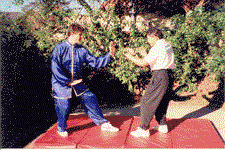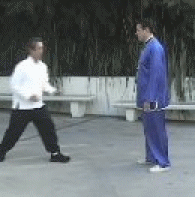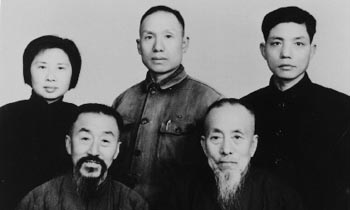The Basic Approach of 12 Animals Style Hsing I Ch'uan (Xingyiquan)
 The foundation of Hsing I Ch'uan (Xing Yi Quan) is the parsing of all actions into five groups which are called the Five Elements (or Five Phases). The basic actions are taught in Hsing I Ch'uan as Five Fists, first as simple individual forms and later linked together. There are a variety of associations with each of the Five Elements, but it is a dual progression that drives the utility of the groupings. In this picture, the name Five Phases seems better capture the concept - but it is less commonly used than "Five Elements." The tactical perspective of the Five Elements is built on destructive and creative progressions and the association of the actions with the five groups:
The foundation of Hsing I Ch'uan (Xing Yi Quan) is the parsing of all actions into five groups which are called the Five Elements (or Five Phases). The basic actions are taught in Hsing I Ch'uan as Five Fists, first as simple individual forms and later linked together. There are a variety of associations with each of the Five Elements, but it is a dual progression that drives the utility of the groupings. In this picture, the name Five Phases seems better capture the concept - but it is less commonly used than "Five Elements." The tactical perspective of the Five Elements is built on destructive and creative progressions and the association of the actions with the five groups:
In Hsing I Ch'uan (Xingyiquan) practice, applications of the destuctive progression (or cycle) of the Five Elements is the foundation when training to deal with an attack:
- Pounding (Fire) intercepts Splitting (Metal) with it's angular parrying raised arm combined with a "pounding" striking fist;
- Drilling (Water) intercepts Pounding's (Fire) strike with a circular parry, followed by a downward deflection combined with a "drilling" uppercut;
- Crossing (Earth) intercepts Drilling's (Water) uppercut with a lateral, "crossing" parry and a hooking strike;
- Bursting (Wood) intercepts Crossing's (Earth) hooking strike with a linear pull combined with a divergent, "bursting" straight-on strike;
- Splitting (Metal) splits Bursting (Wood) with a straight down parry followed closely by a chopping, "splitting" strike; and so on cyclically.
The Twelve Animals are, in essence, a more sophisticated way to utilize the Five Elements of Hsing I Chuan. However, that said, the Twelve Animals have their own constellations and shapes which provide additional influence on the application and healing practices of Hsing I Chuan. Beyond the Twelve Animals though, there is that argument/question as to which came first: The Ten Animals or the Twelve Animals? While it isn't something that is "make or break" for ardent practitioners, it is, in my opinion, something worth considering, as both camps have something to learn from one another.




 The foundation of Hsing I Ch'uan (Xing Yi Quan) is the parsing of all actions into five groups which are called the Five Elements (or Five Phases). The basic actions are taught in Hsing I Ch'uan as Five Fists, first as simple individual forms and later linked together. There are a variety of associations with each of the Five Elements, but it is a dual progression that drives the utility of the groupings. In this picture, the name Five Phases seems better capture the concept - but it is less commonly used than "Five Elements." The tactical perspective of the Five Elements is built on destructive and creative progressions and the association of the actions with the five groups:
The foundation of Hsing I Ch'uan (Xing Yi Quan) is the parsing of all actions into five groups which are called the Five Elements (or Five Phases). The basic actions are taught in Hsing I Ch'uan as Five Fists, first as simple individual forms and later linked together. There are a variety of associations with each of the Five Elements, but it is a dual progression that drives the utility of the groupings. In this picture, the name Five Phases seems better capture the concept - but it is less commonly used than "Five Elements." The tactical perspective of the Five Elements is built on destructive and creative progressions and the association of the actions with the five groups:


